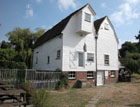Converting a Mill
One should not take on a mill conversion lightly, but once the toil is over, the end result will bring a unique sense of achievement, as well as a stunning historical property


Legend has it that a miller from Outwood, in Surrey watched the great fire of London from the top of his mill. Built in 1665, Grade-I listed Outwood Post Mill stands some 39ft high?enough to make out London in the distance on a good day?and is the oldest working windmill in the country. And like several other mills in Britain, it is now available for sale. Windmills and watermills are some of the most interesting examples of British vernacular architecture. Watermills became common in Britain from at least the 7th century, whereas the earliest windmills appear to date from the 12th century, when they were probably introduced by Crusaders returning from the Holy Land. Rendered obsolete by modern forms of power generation, many crumbled to pieces, leaving gaping holes in the countryside. But several of them are now finding a new lease of life by producing stoneground flour or by turning into hydropower stations?or even homes. Finding a mill for sale is relatively easy. The Society for the Protection of Ancient Buildings has a Mills section (www.spab.org.uk/mills/index.html), which not only protects mills from demolition but also issues a list of old mills for sale. A dedicated mills website, (www.windmillworld.co.uk), also carries details of mills for sale, and many crop up with country estate agents. Buying an old mill, however, is only the beginning. The real job is to bring it back to its former glory while remaining true to its architecture and original use. And here is where the experience of SPAB's Mills section is invaluable. The conservationists at SPAB start from the assumption that 'mills are primarily machines and proposals to convert them to other uses will always be critically examined.' However, they appreciate that conversions to different uses can sometimes be the lesser evil from a preservation viewpoint in extreme circumstances. 'I must stress that it is only as a last resort that the Mills Section would support the conversion of a mill,' says SPAB's Mills Secretary, Simon Hudson. 'If it had lost its power source and or working parts and that there was no opportunity for their reinstastement then a sympathetic re-adaptive use of the building is then the best one could hope for. It should be remembered that working parts of mills are protected by listing.' Any conversion must be sympathetic to the original structure and must try to preserve the mill in its integrity as a working building. After all, as SPAB points out, a poor conversion can destroy a mill just as easily as decay or demolition. 'We try and make sure that whenever a mill in the country is repaired, it is repaired as authentically as possible,' says Hudson. 'A conversion with no regard to the mill's original character is very sad.' For this reason, he urges current and prospective mill owners to take advice from people who operate within the mill world. Each mill should follow dedicated conversion and repair criteria, depending on its architecture, function and period of construction, so talking to a local specialist is critical. 'A local representative [of SPAB's Mills section] would be able to discuss with any owner the structure and repair of a mill,' says Hudson. However, some general good practice principles apply. SPAB's Philosophy of Repair of Windmills and Watermills states that 'in all repair work it is essential that a mill is not regarded merely as a building but as a machine,' so authentic conservation needs to look at mills in their entirety. This includes ancillary buildings such as the miller's home, cart sheds and kilns. Ideally, all working parts should be brought back to full working order, but any repair work is useful so long as it strives to preserve mills as working units. 'The aim of repair should be to retain and maintain as much as possible of the existing structure and machinery in order to preserve the historical and technical integrity of each mill,' states the SPAB document, which recommends that a mill be repaired to the same appearance as when it last worked?both inside and outside. SPAB conservationists urge owners to keep their mill's original features intact and in their appropriate context, documenting the state of the building before and during repair works. Whenever replacements are required, SPAB suggests using sympathetic materials, making sure that new parts are faithful copies of the originals or, if no original part is left to copy from, in keeping with local tradition and practice. Because a mill is essentially a power generator, the relationship with its surroundings is also critical. SPAB recommends making sure that this relationship survives by, for example, maintaining the area around a windmill free of trees and buildings or making sure that water flows freely to a watermill. This should include maintenance of watercourses, dams, weirs and ponds. 'The area around a mill is very, very important but it much has been lost in recent years," says Hudson. 'We are very keen it is maintained because it is all part of the history of the mill.' A number of resources help owners carry out mill repairs. A good starting point is the online Mills Archive database (www.millsarchive.com), which allows registered users free access to information and historic photographs of hundreds of mills across Britain. Anyone about to embark on repair work can see how their mill looked like in the past. Going to visit a good example of local working mill?a place like Wicken, in Cambridgeshire, for example, which was bought by a volunteer group as a wreck and has now been repaired to full working condition?is also a good source of inspiration. Buyers can learn the basic principles of mill repair work by taking a SPAB course or at the very least reading one of their recently published books?Principles and Practice of Windmill Repair and Principles and Practice of Watermill Repair?which have been edited by windmill specialist Vincent Pargeter and watermill specialist Alan Stoyel respectively. SPAB's Mills section also provides a directory of millwrights, which only includes people that sign up to their Philosophy of Repair of Windmills and Watermills and can provide three recent examples of work. A list of suppliers of goods and services which may be useful in mill repair work is also available.
Exquisite houses, the beauty of Nature, and how to get the most from your life, straight to your inbox.
Country Life is unlike any other magazine: the only glossy weekly on the newsstand and the only magazine that has been guest-edited by His Majesty The King not once, but twice. It is a celebration of modern rural life and all its diverse joys and pleasures — that was first published in Queen Victoria's Diamond Jubilee year. Our eclectic mixture of witty and informative content — from the most up-to-date property news and commentary and a coveted glimpse inside some of the UK's best houses and gardens, to gardening, the arts and interior design, written by experts in their field — still cannot be found in print or online, anywhere else.
-
 The greatest flowers make the greatest art
The greatest flowers make the greatest artA search for still-life subjects led Kate Friend to some of the greatest gardens and gardeners in the country
-
 The Castle Howard Mausoleum, a building so beautiful 'you'd almost want to be alive when buried in it', is facing its own demise
The Castle Howard Mausoleum, a building so beautiful 'you'd almost want to be alive when buried in it', is facing its own demiseThe celebrated Castle Howard Mausoleum is a dynastic monument to the Howard family, but it needs further restoration if it is to survive. Christopher Ridgway tells its story; photography by Paul Higham.
